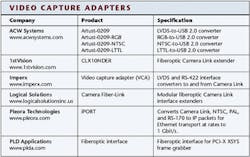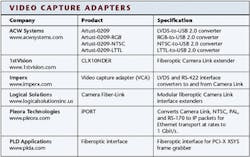Interface converters ease camera systems integration
Recently, several companies, such as Arvoo (Montfoort, The Netherlands; www.arvoo.com), Logical Solutions (Milford, CT; www.logicalsolutionsinc.us), and Control Systems Research (Crestview, FL; csr-fl.com), announced a number of fiber-based optical extenders that allow designers of standards-based machine-vision systems to increase the distance of their camera-to-frame-grabber interfaces (see Vision Systems Design, November 2002, p. 7). In addition, at last year's VISION 2002 in Stuttgart, Germany, and Vision Show West in Santa Clara, CA, other companies entered the camera interface/extender market with a range of products that provide optical extensions, conversion between different camera standards, and interfaces to bus-based protocols.
At Vision Show West, Scott Israel of 1stVision (Andover, MA; www.1stvision.com) announced that his company was manufacturing and marketing the CLX10NDER Camera Link-to-optical extender. While the extender dramatically increases the distance between Camera Link cameras and frame grabbers, the extender uses a fixed fiber distance that must be specified before purchasing.
Recognizing this potential limitation, Logical Solutions re-engineered its original fixed-fiber-length product, the Optic Link CL-XX-X, as the Camera Fiber Link, a pair of modular transceivers that uses a plug-in MDR-26 cable for Camera Link interfacing and a modular plug-in duplex multimode optical cable for up to a 500-m data transmission.
PLD Applications (Aix-en-Provence, France; www.plda.com) also has developed an optical extension to its range of PCI-X XSYS range of frame grabbers. The Camera Link-to-fiberoptic PMC module is offered as both a stand-alone unit and as a PMC-based plug-in module for the PCI-X XSYS, a Base/Medium/Full Camera Link frame grabber that features a 64-bit, 133-MHz host PCI-X bus. At VISION 2002, the company demonstrated the power of the system in a parallel image-processing application.
In the show demonstration, images from an A202k, 1024 × 1024-pixel, 48 frame/s camera from Basler AG (Ahrensburg, Germany; www.baslerweb.com) were converted to a 2-Gbit/s data stream using a stand-alone Camera Link-to-fiberoptic converter. The data were then transmitted over fiber to the add-in PMC board on the XSYS frame grabber and, at the same time, retransmitted to a similar system over a fiber connector. In both systems, a standard AGP Rage graphics card from ATI Technologies (Markham, ON, Canada; www.ati.com) displayed the images.
Of course, not every camera vendor currently offers Camera Link-compatible products. Many older designs are based on the LVDS standard, which uses a greater number of connections in the interface cable. Now, however, developers wishing to convert LVDS data to Camera Link format or vice versa can purchase the Video Capture Adapter from Imperx (Boca Raton, FL; www.imperx.com). This stand-alone interface adapter converts the interface signals from cameras using LVDS standards to a set of signals fully compatible to the Base configuration Camera Link interface.
For developers who need to transmit captured data over standard buses such as USB 2.0 or Gigabit Ethernet, start-ups ACW Systems (Surrey, BC, Canada; www.acwsystems.com) and Pleora Technologies (Kanata, ON, Canada; www.pleora.com) might have the method. ACW Systems, a representative of Artray Co. Ltd. (Tokyo,Japan; www.artray.co.jp), offers a host of products to convert nearly every conceivable digital and broadcast format to USB format (see table).
For its part, Pleora Technologies has introduced iPORT, an interface that allows cameras and imagers to send IP-formatted data at speeds to 1 Gbit/s over long reaches of Category-5 copper cable. The iPORT architecture consists of a protocol engine, a device driver, and a SDK. During operation, the iPORT protocol engine for cameras converts video data, including Camera Link, NTSC, PAL, and RS-170 formats, into IP packets for Ethernet transport.

